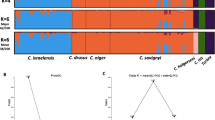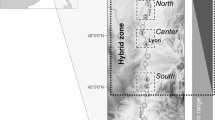Abstract
High-resolution genetic markers have revolutionized our understanding of vertebrate mating systems1, but have so far yielded few comparable surprises about kinship in social insects. Here we use microsatellite markers to reveal an unexpected and unique social system in what is probably the best-studied social wasp, Polistes dominulus. Social insect colonies are nearly always composed of close relatives2,3; therefore, non-reproductive helping behaviour can be favoured by kin selection, because the helpers aid reproductives who share their genes4. In P. dominulus, however, 35% of foundress nestmates are unrelated and gain no such advantage. The P. dominulus system is unlike all other cases of unrelated social insects, because one individual has nearly complete reproductive dominance over subordinates who could have chosen other reproductive options. The only significant advantage that subordinates obtain is a chance at later reproduction, particularly if the queen dies. Thus, P. dominulus societies are functionally unlike other social insects, but similar to certain vertebrate societies5,6, in which the unrelated helpers gain through inheritance of a territory or a mate.
This is a preview of subscription content, access via your institution
Access options
Subscribe to this journal
Receive 51 print issues and online access
$199.00 per year
only $3.90 per issue
Buy this article
- Purchase on Springer Link
- Instant access to full article PDF
Prices may be subject to local taxes which are calculated during checkout




Similar content being viewed by others
References
Hughes, C. R. Integrating molecular techniques with field methods in studies of social behavior: a revolution results. Ecology 79, 383– 399 (1998).
Crozier, R. H. & Pamilo, P. Evolution of Social Insect Colonies: Sex Allocation and Kin Selection (Oxford Univ. Press, Oxford, 1996).
Queller, D. C. & Strassmann, J. E. Kin selection and social insects. Bioscience 48, 165–174 (1998).
Hamilton, W. D. The genetical evolution of social behaviour. I, II. J. Theor. Biol. 7, 1–52 (1964 ).
Reyer, H.-U. Investment and relatedness: a cost/benefit analysis of breeding and helping in the pied kingfisher (Ceryle rudis). Anim. Behav. 32, 1163–1178 (1984).
Creel, S. R. & Waser, P. M. Inclusive fitness and reproductive strategies in dwarf mongooses. Behav. Ecol. 5, 339–348 (1994).
Reeve, H. K. in The Social Biology of Wasps (eds Ross, K. G. & Matthews R. W.) 99–148 (Cornell Univ. Press, Ithaca, 1991).
Pardi, L. Dominance order in Polistes wasps. Physiol. Zool. 21, 1–13 (1948).
Turillazzi, S., Marino Piccioli, M. T., Hervatin, L. & Pardi, L. Reproductive capacity of single foundress and associated foundress females of Polistes gallicus (L.) (Hymenoptera Vespidae). Monitore Zool. Ital. (N. S.) 16, 75–88 (1982).
Pratte, M. Relations antérieurs et association de fondation chez Polistes gallicus L. Insectes Sociaux 29, 352– 357 (1982).
Röseler, P. F. in Experimental Behavioral Ecology and Sociobiology (eds Hölldobler, B. & Lindauer, M.) 259–272 (Sinauer, Sunderland, 1985).
Bernasconi, G. & Strassmann, J. E. Cooperation among unrelated individuals: the ant foundress case. Trends Ecol. Evol. 14, 477–482 ( 1999).
Kukuk, P. F. & Sage, G. K. Reproductivity and relatedness in a communal halictine bee, Lasioglossum (Chilalictus) hemichalceum. Insectes Sociaux 41, 443– 455 (1994).
Rissing, S. W., Pollock, G. B., Higgins, M. R., Hagen, R. H. & Smith, D. R. Foraging specialization without relatedness or dominance among co-founding ant queens. Nature 337, 420–422 (1989).
Vehrencamp, S. L. Optimal degree of skew in cooperative societies. Am. Zool. 23, 327–335 (1983).
Reeve, H. K. & Ratnieks, F. L. W. in Queen Number and Sociality in Insects (ed Keller, L.) 45–85 (Oxford Univ. Press, Oxford, 1993).
Pardi, L. Ricerche sui polistini 11. Sulla durata permanenze della femmine nel nido e sul accrescimento della societa in Polistes gallicus (L.). Atti Soc. Toscana Sci. Nat. 55, 3– 15 (1948).
Bourke, A. F. G. & Franks, N. R. Social Evolution in Ants (Princeton Univ. Press, Princeton, USA, 1995 ).
Lorenzi, M. C. & Cervo, R. Usurpations and late associations in the solitary founding social wasp, Polistes biglumis bimaculatus (Hymenoptera: Vespidae). J. Insect Behav. 8, 443–451 (1995).
Zacchi, F. Genetic structure of Polistes dominulus foundress associations. PhD thesis, Rice University, Houston (1998).
Gamboa, G. J., Reeve, H. K. & Pfennig, D. W. The evolution and ontogeny of nestmate recognition in social wasps. Annu. Rev. Entomol. 31, 431–454 (1986).
Kokko, H. & Johnstone, R. A. Social queuing in animal societies: a dynamic model of reproductive skew. Proc. R. Soc. Lond. B 266, 571–578 (1999).
Ragsdale, J. E. Reproductive skew theory extended: the effect of resource inheritance on social organization. Evol. Ecol. Res. 1, 859– 874 (1999).
Strassmann, J. E., Solís, C. R., Barefield, K. & Queller, D. C. Trinucleotide microsatellite loci in a swarm-founding neotropical wasp, Parachartergus colobopterus and their usefulness in other social wasps. Mol. Ecol. 5, 459–461 (1996).
Strassmann, J. E. et al. Trinucleotide microsatellite loci and increased heterozygosity in cross-species applications in the social wasp, Polistes. Biochem. Genet. 35, 273–279 (1997).
Strassmann, J. E., Barefield, K., Solís, C. R., Hughes, C. R. & Queller, D. C. Trinucleotide microsatellite loci for a social wasp, Polistes. Molec. Ecol. 6, 97–100 (1997).
Strassmann, J. E., Solís, C. R., Peters, J. M. & Queller, D. C. in Molecular Zoology: Advances, Strategies and Protocols (eds Ferraris, J. D. & Palumbi, S. R.) 163–180, 528–549 (Wiley-Liss, New York, NY, 1996).
Queller, D. C. & Goodnight, K. F. Estimating relatedness using genetic markers. Evolution 43, 258–275 (1989).
Goodnight, K. F. & Queller, D. C. Computer software for performing likelihood tests of pedigree relationship using genetic markers. Mol. Ecol. 8, 1231–1234 (1999).
Strassmann, J. E. et al. Genetic relatedness in primitively eusocial wasps. Nature 342, 268–270 ( 1989).
Acknowledgements
We thank G. Bernasconi and L. Keller for helpful comments on the manuscript and ENEL SpA PDT Centro for the permission to work in the re-forestation area of the ‘Miniera di Santa Barbara’. This work was supported by the NSF (US) and the Italian MURST. We dedicate this paper to the memory of Bill Hamilton, who taught us how to think about social insect evolution.
Author information
Authors and Affiliations
Corresponding author
Rights and permissions
About this article
Cite this article
Queller, D., Zacchi, F., Cervo, R. et al. Unrelated helpers in a social insect. Nature 405, 784–787 (2000). https://doi.org/10.1038/35015552
Received:
Accepted:
Issue Date:
DOI: https://doi.org/10.1038/35015552
This article is cited by
-
Annual fitness costs may be balanced by a conservative life history strategy in groups of unrelated ant queens
Behavioral Ecology and Sociobiology (2023)
-
A Strepsipteran parasite extends the lifespan of workers in a social wasp
Scientific Reports (2021)
-
Ten recent insights for our understanding of cooperation
Nature Ecology & Evolution (2021)
-
Nutrition induced direct fitness for workers in a primitively eusocial wasp
Insectes Sociaux (2021)
-
Cooperation by ant queens during colony-founding perpetuates alternative forms of social organization
Behavioral Ecology and Sociobiology (2021)
Comments
By submitting a comment you agree to abide by our Terms and Community Guidelines. If you find something abusive or that does not comply with our terms or guidelines please flag it as inappropriate.



